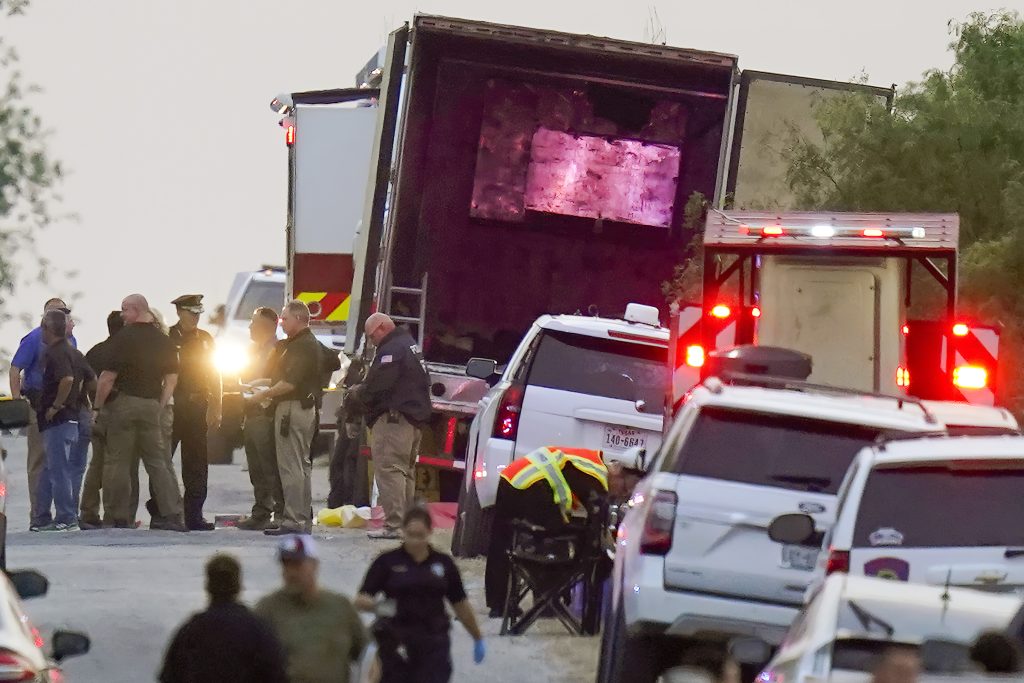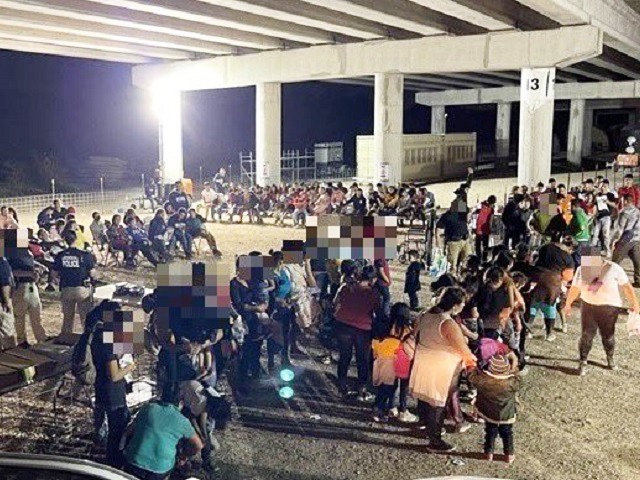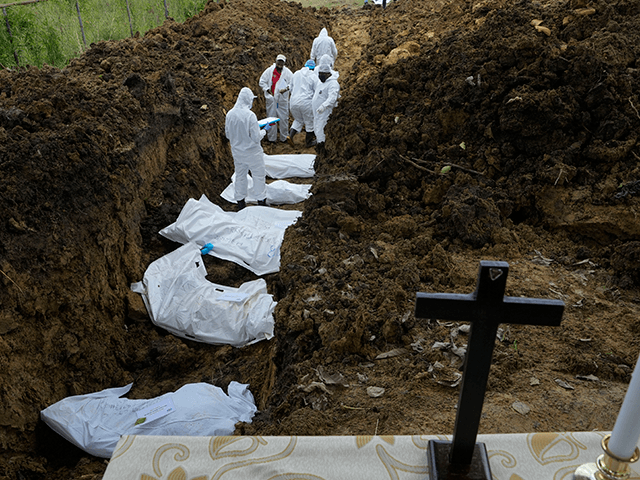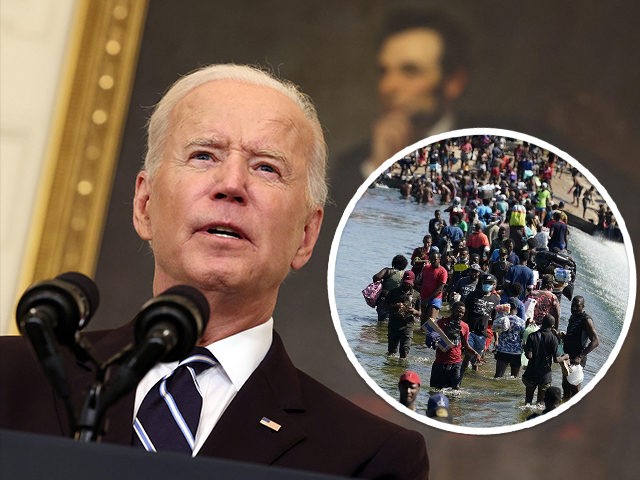The death of 53 illegal migrants in a San Antonio trailer truck has spotlighted the damage caused by the federal government’s off-the-books policy of juicing the U.S. economy with young people extracted from poor countries.
The 53 dead migrants rationally got into the San Antonio trailer on June 27 because they expected to get what earlier migrants have already won — work, homes, and a peaceful life in the United States.
But their price of access to U.S. jobs, however, was the obligation to travel via the expensive, lethal, and off-the-books obstacle course of coyotes, cartels, cops, mountains, deserts, and rivers. The 53 died because an allegedly drug-using truck driver did not notice the trailer’s failing air-conditioner.
Their deaths are now being memory-holed because that unofficial migration path is being protected by the U.S. government.
It is being protected because it exists to help both parties’ legislators deny any responsibility for the hands-off mass-migration policy that aids investors in the U.S. economy — but which also damages 150 million Americans’ wages, housing, and productivity.

Police and other first responders work the scene where officials say dozens of people have been found dead and multiple others were taken to hospitals with heat-related illnesses after a semitrailer containing suspected migrants was found, Monday, June 27, 2022, in San Antonio. (AP Photo/Eric Gay)
The 53 victims of this government-protected, labor-trafficking system included two teenagers from the Mexican state of Veracruz who paid their smuggling fees with $20,000 from the sale of their mother’s house. The youths expected to join relatives in the United States and then repay the debt with U.S. wages, according to a July 1 report from the Associated Press:
Teófilo Valencia, father of 19-year-old Jair and 16-year-old Yovani sat looking at his phone, reading the last messages he received from them. “Dad, now we’re going to San Antonio,” Yovani wrote at 11:16 a.m. Monday. A half-hour later, his brother wrote to their father that they were ready to work hard and pay for everything.
Another victim was Javier Flores, who was born in a very poor corner of Mexico. He “called his family [on] June 19, when he told them he had already crossed the border and was hiding in a house in Texas,” said a Reuters report on June 29:
Flores’ family is now anxiously hoping for news that he is alive. “He told me he was going to look for a better life,” Flores’ mother, Virgilia Lopez, told Reuters. “To send his kids to school, help them get ahead and have a better future.”
The Associated Press reported on June 30 on another victim, Javier Lopez:
López’s family was waiting to find out whether he was on the truck. He had returned home [from his U.S. job] to see his wife and three small children in southern Mexico and was going back to Ohio where his father and a brother live and he worked in construction. He is now among the missing and his cousin, José Luis Vásquez Guzmán, is hospitalized in San Antonio, the family said.
The migration and the deaths continue because “our [U.S.] leadership class doesn’t believe in the legitimacy of immigration law,” explained Mark Krikorian, the director of the Center for Immigration Studies. They “tolerate mass illegality as a way of getting around the [annual] immigration limits set by Congress,” he told Breitbart News.
Numbers
The annual legal inflow is about one million legal immigrants per year, or roughly one legal immigrant for every four Americans who enter the workforce each year.
But since early 2021, President Joe Biden’s deputies have admitted perhaps 2 million southern migrants, including many who sneaked past the small and overworked force of border patrol officers.
In contrast, Trump’s agents admitted 253,000 migrants during 2020, amid furious opposition from the Democratic Party and many business groups.
Krikorian argues that the unofficial migration path is the deliberate and disguised choice of a pro-migration elite.
But pro-migration advocates say the U.S. superpower just can’t stop the migrants.
The federal government is “allowing a lot of people in simply because they don’t have capacity [at the border] to process people, [or] to give them asylum hearings, [or] to return them to their countries of origin,” argued Andrew Selee, the president of the Migration Policy Institute.
But that failure is a green light for more migrants, he admitted. “Clearly, what we’re seeing [at the border] is people are seeing that [lack of border capacity] as a signal that it’s time to come,” Selee told C-SPAN on July 1.
This year, the government of the U.S. superpower has the capacity to spend $6.8 trillion on its priority operations, including a $50 billion proxy war in Ukraine and a national shift away from fossil fuels. And Biden’s border chief — Alejandro Mayorkas — is an aggressive manager and an expert lawyer who is changing many regulations to boost migration.
Mayorkas was quick to blame the smugglers for the disaster, even though he requires border agents to welcome the smugglers’ migrant clients and to pass them on to migrant-aid groups in the United States.
Yet Selee says the migration cannot be blocked because of federal incompetence: “We’ve lost the ability to make decisions about who needs to come in and who doesn’t at this point,” Selee insisted.
Migration’s Costs
Whatever the cause, the unofficial migration sucks energy and life from small poor countries south of Texas.
“We’re strip-mining these countries of their talent,” Krikorian said.
“They’re blue-collar workers …. but they’re the people with some enterprise and get-up-and-go, and that’s the kind of people in developing country needs,” he added. “That’s not promoting the development of these countries.”
Rather than extract their workers and consumers, the U.S. should be promoting mutually beneficial trade, he said.
In 2017, U.S. investors invested only about $4 billion in the three main sending countries of Central America – Honduras, El Salvador, and Guatemala. Those investors put $8 billion in Costa Rica and Panama, which have low rates of emigration.
“Instead of sending us the product of their people’s labor, they just sending us their people: How is that good for anybody?” said Krikorian.
The unofficial pathway has existed for at least 30 years — and so many structural pressures push and pull migrants to the U.S. economy.

RGV Sector agents apprehended a large group of migrants near the Texas border with Mexico. (U.S. Border Patrol/Rio Grande Valley Sector)
“On the one hand, [there are] real opportunities to work in the U.S., and [there are] some circumstances that are really pushing people out of their communities in Latin America and elsewhere around the world,” said Selee.
The pull comes from friends and relatives who have migrated into U.S. jobs: “Most migrants rely on those who have made it to the U.S. to send them money for the journey, which usually costs around $9,000,” the Associated Press wrote in July 1.
‘When a relative of Andino Caballero’s living in the United States offered to help him and his younger brother, 18-year-old Fernando José Redondo Caballero, finance the trip north, they were ready,” CBS reported on June 30:
Caballero last spoke to them Saturday morning. They told her they had crossed the Rio Grande at Roma, Texas, were headed to Laredo and on Monday expected to head north to Houston.
[…]
The deaths [in the truck] of her sons and Paz Grajeda, who was like a daughter, are devastating. “My children leave a void in my heart,” she said. “We’re going to miss them a lot.”
The push comes from the distorted social pressure within communities that are funded by wages from migrant workers in the United States. The AP reported:
Wilmer’s father, Manuel de Jesús Tulul, could not stop crying Wednesday …Tulul said [13-year-old] Wilmer did not see a future for himself in a town where modest homes were built with remittances sent from the United States. He wanted to help support his three siblings and have his own house and land some day.
“All of the young people start to think about going (to the U.S.) as soon as they turn 18,” migrant activist Carmelo Castañeda told the Miami Herald.
Migrant Deaths
The unofficial-but-welcomed migration path kills a lot of people.
For example, the federal government’s eagerness to suck workers and consumers from poor countries also helps to separate foreign children from their migrant parents. The Washington Post reported on June 30
Pascual Melvin Guachiac Sipac left Sololá, Guatemala, 15 days ago to live with his dad in Houston. On Wednesday morning, the [the 13-year-old] teen’s mother, Maria Sipac Coj, received a call from a local congressman telling her that her son’s body had been found in the trailer. “He was so excited to be with his father again,” she said, weeping.
Media outlets got some details of the truck disaster wrong. For example, two girls who reportedly died on the truck died at another location on the federal government’s unofficial route to U.S. jobs. According to a Reuters report:
A spokesperson for Guatemala’s foreign ministry,Karla Samayoa, said two Guatemalan girls who had been identified on social media as supposed victims of the San Antonio truck smuggling tragedy had in fact drowned in the Rio Grande.
Those elsewhere deaths are rising fast.

A forensics team bury a group of 15 migrants who died trying to cross the Darien Gap, at the Guayabillo cemetery in Agua Fria, Panama, Thursday, Sept. 30, 2021. The migrants die of natural causes or in accidental deaths while crossing the Darien jungle trying to make their way to the United States. (AP Photo/Arnulfo Franco)
“We are at 51 deaths [in 2022] and the summer heat is just now beginning,” Brooks County Sheriff Benny Martinez told Breitbart Texas on June 29. “With temperatures reaching in excess of 100 degrees, many [migrants] are simply not prepared for what they face when smugglers drop them off in the southern part of the county and send them on their way.”
Other migrants die at sea, on highways, in deserts, rivers, jungles, and snow as they try to get through the unofficial obstacle course to U.S. jobs.
“At least 728 … deaths occurred on the United States-Mexico border crossing, making this the deadliest land crossing in the world,” said a July 1 report from the United Nation’s International Organization for Migration.
The Federal Welcome
Amid the rising inflow and death toll, the courts, Congress, and the White House continue to roll back President Donald Trump’s successful programs to curb the official and unofficial routes for extraction migration.
For example, Congress and the White House refuse to hire anywhere near enough agents to police the labor trafficking. The Washington Post reported on July 1:
“The truck was waved through because the traffic was backing up,” [Rep. Henry Cuellar (D-TX] said, noting that many of the Border Patrol agents in South Texas are busy “taking care of migrants” arriving in record numbers.
[…]
“There’s an issue with manpower and they don’t have the right or same technology at checkpoints that they do at ports of entry,” Cuellar said. “It’s one of those things.”
“The [San Antonio] truck was waved through [highway checkpoints] because the traffic was backing up,” Cuellar told the Washington Post, adding that many of the Border Patrol agents in South Texas are busy “taking care of [other] migrants.”
The Department of Homeland Security and the Department of Justice have minimized the arrest and deportation of illegal migrants. Unsurprisingly, the San Antonio smugglers reportedly included two illegal migrants who have been living, apparently unmolested by the feds, in the United States, according to the Post:
In addition to Zamorano and Martinez, Juan Claudio D’Luna-Mendez, 23, and Juan Francisco D’Luna-Bilbao, 48, both citizens of Mexico, were arrested on charges of being undocumented immigrants in possession of several weapons and at least one rifle. If convicted of the weapons charges, both defendants face up to 10 years in prison.
The Post reported:
Cynthia Orr, the court-appointed lawyer for D’Luna-Bilbao, said D’Luna-Bilbao is the father of D’Luna-Mendez and both live there with their family and work as mechanics. She said they owned weapons to defend themselves against crime in the neighborhood and emphasized that they have not been charged with smuggling.
Elsewhere, DHS helps migrants get jobs to aid the next wave of migrants:
One migrant, Jose Prinn, said he relates to the victims and survivors of Monday’s tragedy because he almost drowned crossing into Texas. “God saved me,” Prinn said.
“The birds do not need passports to migrate. This land belongs to God. We are only human beings trying to pass,” Prinn said.
Prinn is now at Corazon Ministries helping migrants and the homeless. He was a science professor in his home country of Venezuela.
The federal government has also quietly built safer paths for unofficial white-collar migrants.
The result is a U.S. workforce of at least one million non-immigrant foreign workers. They arrive by safe aircraft, carrying the B-1/B-2 non-work visa, the Optional Practical Training program for people defined as students, the supposedly short-term H-1B program, the L1 program for temporary transfers who are paid at home-country salary rates, ad various ad-hoc programs and regulatory expansions.
That resulting flood of white-collar workers has inflated stock values and damaged innovation by pushing at least many hundreds of thousands of American professionals out of well-paid careers in Fortune 500 companies and major universities.
How do Governments Gain From Unofficial Migration?
But the unofficial paths are good for leaders in the U.S. government because it helps the leading business groups in the United States.
The flood of migrants created a multi-decade bubble of plentiful labor in the United States, it cut wages for Americans, shifted wealth from the interior states to the coasts, reduced pressure for foreign investment, reduced spending on productivity, and allowed elites to disregard the suffering of ordinary — and apparently, replaceable — Americans.
Migration has been good for government leaders in sending countries. For example, migration extracts young people from poor countries, so preventing them from demanding economic improvements. On June 30, the Association Press reported:
In some regions of Mexico, attempting to cross into the United States is a tradition that most youths in heavily migrant towns at least consider. “All of the young people start to think about going (to the U.S.) as soon as they turn 18,” said migrant activist Carmelo Castañeda, who works with the nonprofit Casa del Migrante. “If there aren’t more visas, our people are going to keep dying.”
Washington Post columnist León Krauze reported on June 29 how Mexico’s government gains from the unofficial migration:
Between 2020 and 2021, during an alarming surge in homicides, the number of people displaced due to violence in Mexico quadrupled. The economy remains stagnant. These factors combine to leave many increasingly desperate to make the precarious journey to and across the border.
“Not enough jobs have been created in Mexico,” says [Carlos] Heredia. [Tonatiuh] Guillén agrees. “The number of Mexican deaths in Texas portrays just this recomposition of the Mexican flow,” he told me.
[…]
In an interview at the beginning of his administration, López Obrador mused: “A day will come during my government that Mexicans will not go to work in the United States, because they will have jobs and will be happy where they were born.” The dozens of Mexican bodies piled inside that truck in the sweltering Texas heat bely that promise, in the most tragic way possible.
Since the 1990s, establishment outlets have glossed over the government’s unofficial migration path, and the journalists continue to put employers’ financial interests ahead of Americans’ economic and civic interests.
The New York Times, for example, posted a July 1 article about the San Antonio disaster to push for more legalized migration:
The tragedy in San Antonio should be a wake-up call for the United States to create safer pathways for migration, [Mexican official Carlos] Escalante said. …
The likelihood of any movement in Washington on migration measures, like an increase in temporary worker visas that businesses are lobbying for, is slim since immigration is a hot-button topic Republicans can use to stoke their base ahead of the November midterm elections, [Maureen Meyer, at the pro-migration Washington Office of Latin America] said.
“We need to create some legal pathways for people to come — the U.S. economy needs right now a lot of low-wage workers,” said Selee.
In reality, migration has helped push at least 10 million prime-age men out of the U.S. workforce and has reduced investment in labor-saving devices.
But Trump’s 2020 cutbacks in migration burst the cheap-labor bubble. He pressured investors to recruit and train the sidelined Americans, invest in productivity-boosting technology, and expand trade with the home countries of potential migrants.
The 53 deaths in the trailer “represent some of the costs of our dishonest approach to immigration,” said Krikorian, adding:
We — especially under this administration — reward illegal immigrants who’ve made it past the border patrol with the ability to stay in work in the United States. That is illegal, but nobody’s enforcing the law so there’s virtually no chance they’ll be found out and that makes it [for the migrants] worth taking these kinds of risks.
“Some people will die in the process, and the supporters of mass immigration don’t like that,” he said, adding, “but they can live with it if that’s the price of maintaining this continual flow of people into the U.S.”
Extraction Migration
Since at least 1990, the D.C. establishment has extracted at least 40 million migrants and visa workers from poor countries to serve as legal or illegal workers, temporary workers, consumers, and renters for various U.S. investors and CEOs.
This economic strategy of Extraction Migration has no stopping point. It is brutal to ordinary Americans because it cuts their career opportunities, shrinks their salaries and wages, raises their housing costs, and has shoved at least ten million American men out of the labor force.
Extraction migration also distorts the economy and curbs Americans’ productivity, partly because it allows employers to use stoop labor instead of machines. Migration also reduces voters’ political clout, undermines employees’ workplace rights, and widens the regional wealth gaps between the Democrats’ big coastal states and the Republicans’ heartland and southern states.
An economy built on extraction migration encourages wealthy elites to shift their sympathy to grateful migrants, and away from the despairing Americans at the bottom of society who sometimes vote against the elites’ political interests. That migration-enabled betrayal of fellow citizens then alienates young people and radicalizes Americans’ democratic civic culture.
The extraction migration economic policy is hidden behind a wide variety of noble-sounding excuses and explanations. For example, progressives claim that the U.S. is a “Nation of Immigrants” that Americans have a duty to accept foreign refugees, and that the state must renew itself by replacing populations.
But the colonialism-like economic strategy also kills many migrants, exploits poor people, and splits foreign families as it extracts human-resource wealth from the poor home countries. The migration policy also minimizes shareholder pressure on companies to build up beneficial trade with poor countries.
The polls show deep and broad public opposition to labor migration and the inflow of temporary contract workers into jobs sought by young U.S. graduates.
The opposition is growing, anti-establishment, multiracial, cross-sex, non-racist, class-based, bipartisan, rational, persistent, and recognizes the solidarity that citizens owe to one another.

COMMENTS
Please let us know if you're having issues with commenting.